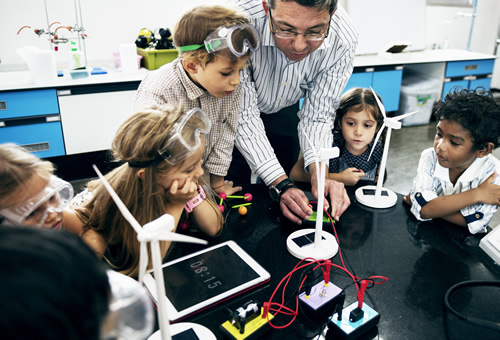[Editor’s note: Today’s stories take a two-pronged look at rural brain drain. This story examines the issue from an educator’s perspective. Look at the issue from the tech community’s perspective here.]
More than 30 years ago, the Department of Justice researched and concluded that stronger families and communities create successful school environments. Fast forward to the present day, the importance of that link between the community and school is still vital for student success. There’s a give and take relationship with the education system and its community, meaning higher standards and stronger school systems encourage the community outside of the school to succeed as well.
With this in mind, a common problem in rural area schools is bridging that gap between school books and real-world experiences – particularly when it comes to STEM. With STEM fields expanding, it’s important to show students in rural communities how they can learn to be innovators and problem solvers for this generation.
Related content: STEM learning invigorates classrooms
In a small town, it doesn’t take much to help foster a child’s dreams and ambitions. It starts with a local business owner hosting a career fair, an optometrist judging a science fair, or a published author reading in their former classroom. With a community in tow, we need to cultivate their imagination and explore all possibilities by preparing them for the workforce, especially in the areas of STEM.
At the same time, this allows students to become more aware of the opportunities in their own small towns and could even encourage them to stay local instead of succumbing to the effects of “Rural Brain Drain,” a term referring to how students are forced to look for careers outside of their hometowns, often in rural areas, due to limited career options in their fields of interest, particularly STEM.
Hands-on learning has always been a valued concept in America. It is a fact that students learn more when they are engaged in the learning process. Challenging communities and school districts to embrace its local resources will lead to conclusions teachers never thought possible. Communities can offer schools more than just funds, they can offer knowledge, careers, and time.
Below are a few examples for how educators and their communities can foster support for STEM learning:
● Upgrade the field trip: Field trips allow students to see what’s happening, firsthand, in their own communities. Reach out to local businesses and companies with some kind of STEM-tie to set up an interactive field trip experience. Most students’ interest isn’t peaked by just seeing how something works, so encourage these businesses to set up a hands-on opportunity. If a student is given a task and they’ve problem solved and watched themselves succeed, that’s when they realize the opportunity available to them through additional learning experiences. That’s how students begin to make connections between textbook learning and the real world.
● Look for local issues: Inspire your students to solve a local community issue and apply for the Samsung Solve for Tomorrow Contest. This nation-wide contest encourages greater personal investment by students because they’re solving problems in their own communities. The contest also exposes students to a greater network of community leaders by challenging them to identify practical solutions for solving a common challenge – pushing them to learn beyond their every day classroom setting.
● Start an after-school club: Extra-curricular activities are another valued source for building relationships locally. After-school clubs create an excellent venue for students to learn by experience. By using hands-on projects with real-world curriculum, students will be able to interact on a local level with very real values. Coding and STEM clubs are designed to provide students with hands-on experience with real-life problems. These hands-on learning experiences are showing children what chapter they will be in, what careers they can have and how they can change the world.
● Create a makerspace: Many schools are implementing Makerspaces throughout the South. Makerspaces are classrooms or spaces stocked with hands-on manipulatives to foster a more advanced learning curriculum. By providing hands-on learning, students are interacting with the world and community in a personal and non-traditional way. A student’s own natural curiosity will inspire growth through Makerspaces, which provide a strong academic foundation for STEM and project-based learning. This mindset and curriculum are crucial for rural students, with limited resources outside of a school’s makerspace. In order for students to achieve in today’s global economy, they need the skills adopted in these types of classroom settings.
I’ll end with a story of one of these examples in action. In 2015, a local engineer visited a sixth-grade classroom here at Nicholson Elementary in Piscayune, Mississippi. He detailed the Engineering Design Process by describing real-world projects at NASA’s Stennis Space Center.
Shortly after these visits, the classroom of 11-year-olds brainstormed a way to implement the Engineering Design Process following discussions with local community members on drainage issues in the town. With the help of a local engineer and community members, this group of students were then able to develop solutions to a city-wide drainage issue. When they realized their capabilities, they competed in the Samsung Solve for Tomorrow Contest and became National Finalists in the contest. As a result, these students earned their school technology and other prizes valued at $138,000 from Samsung.
There’s a give and take relationship with the education system and its community, and it starts with local leaders walking into the classroom. This was the story of my students in 2015 and it ends with each of them beaming with pride and acquiring greater confidence because of the success they uncovered when they tapped into their potential.
- 3 ways to avoid summer learning loss - April 19, 2024
- High school students say AI will change the workforce - April 18, 2024
- Motivating students using the Self-Determination Theory - April 17, 2024


